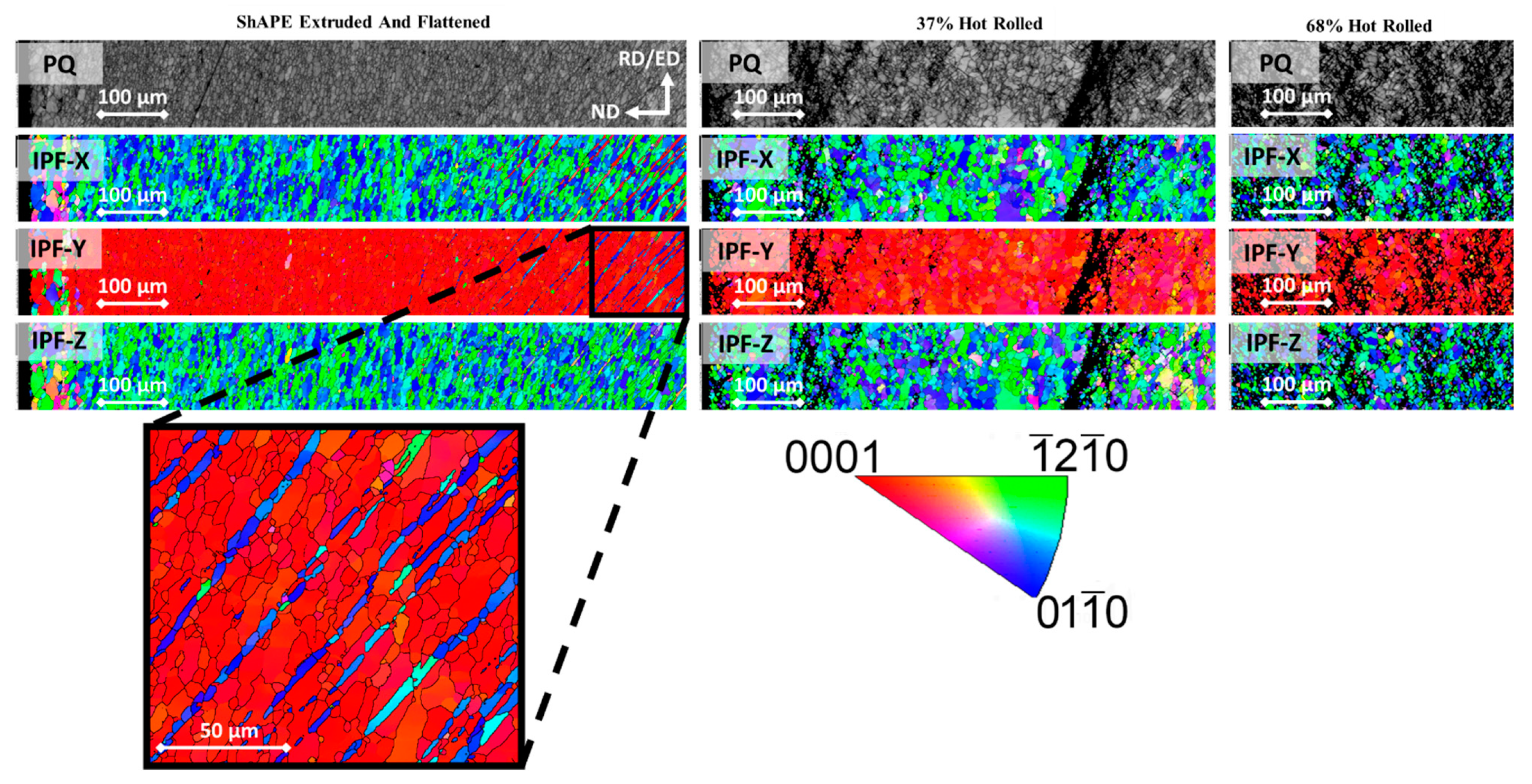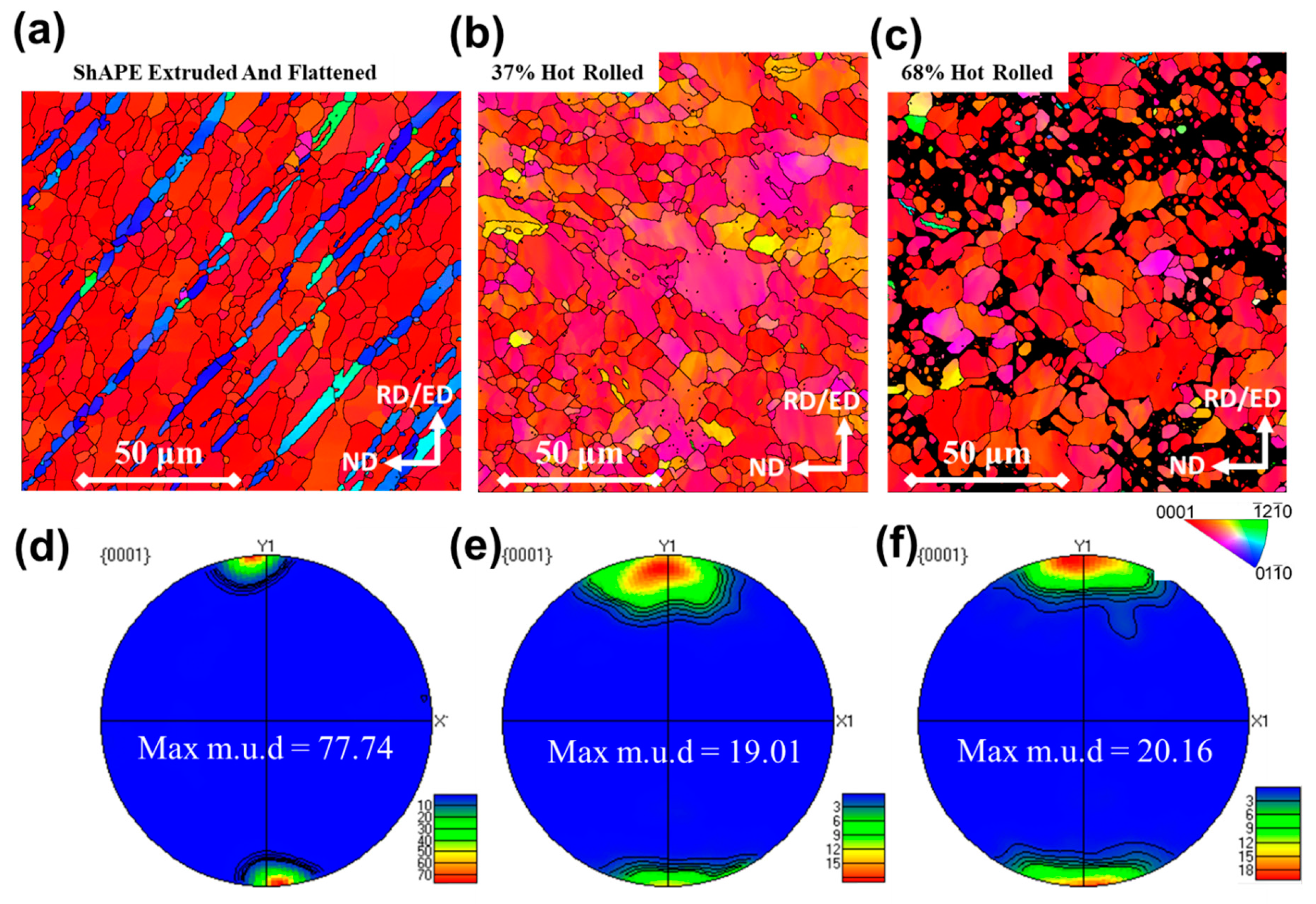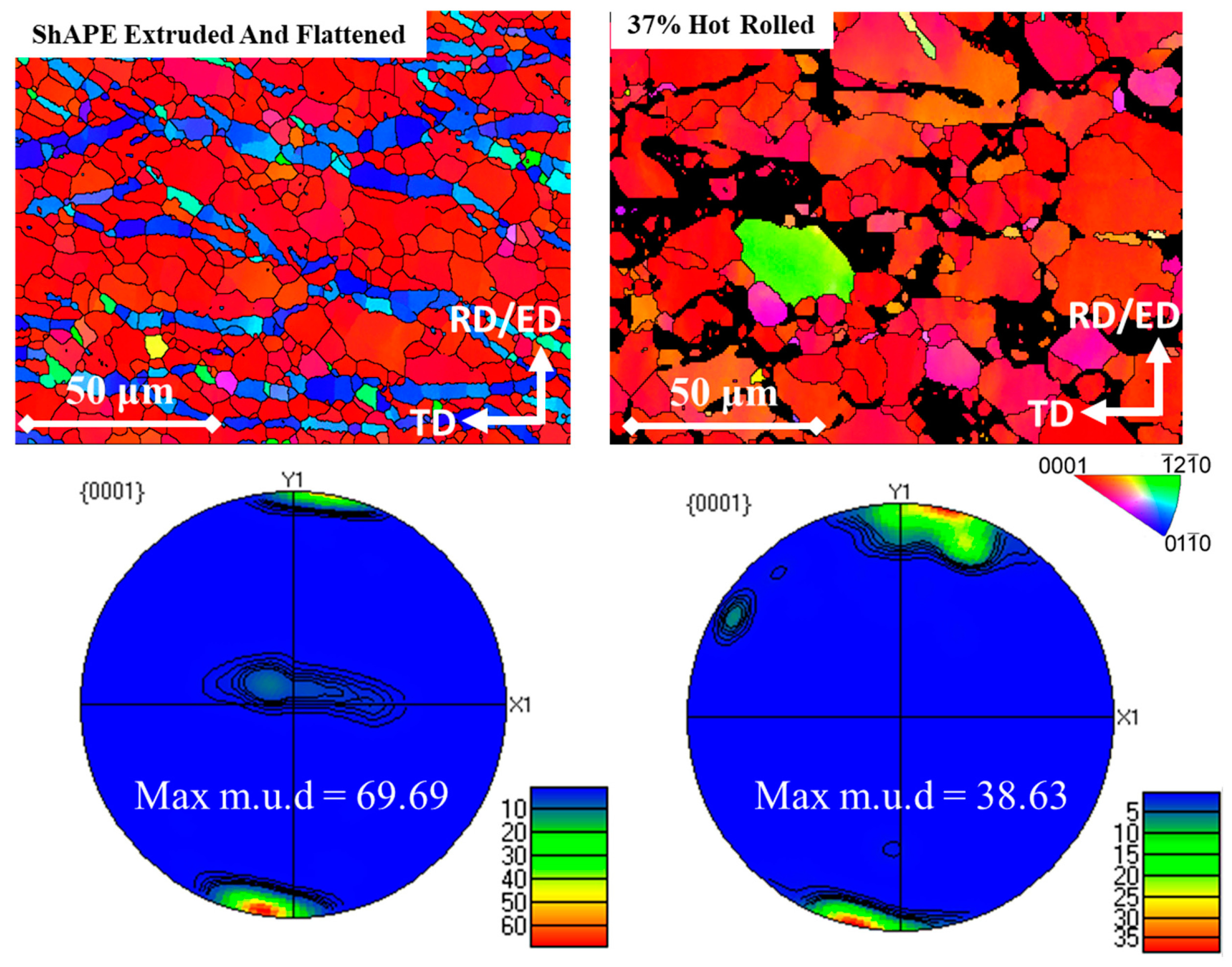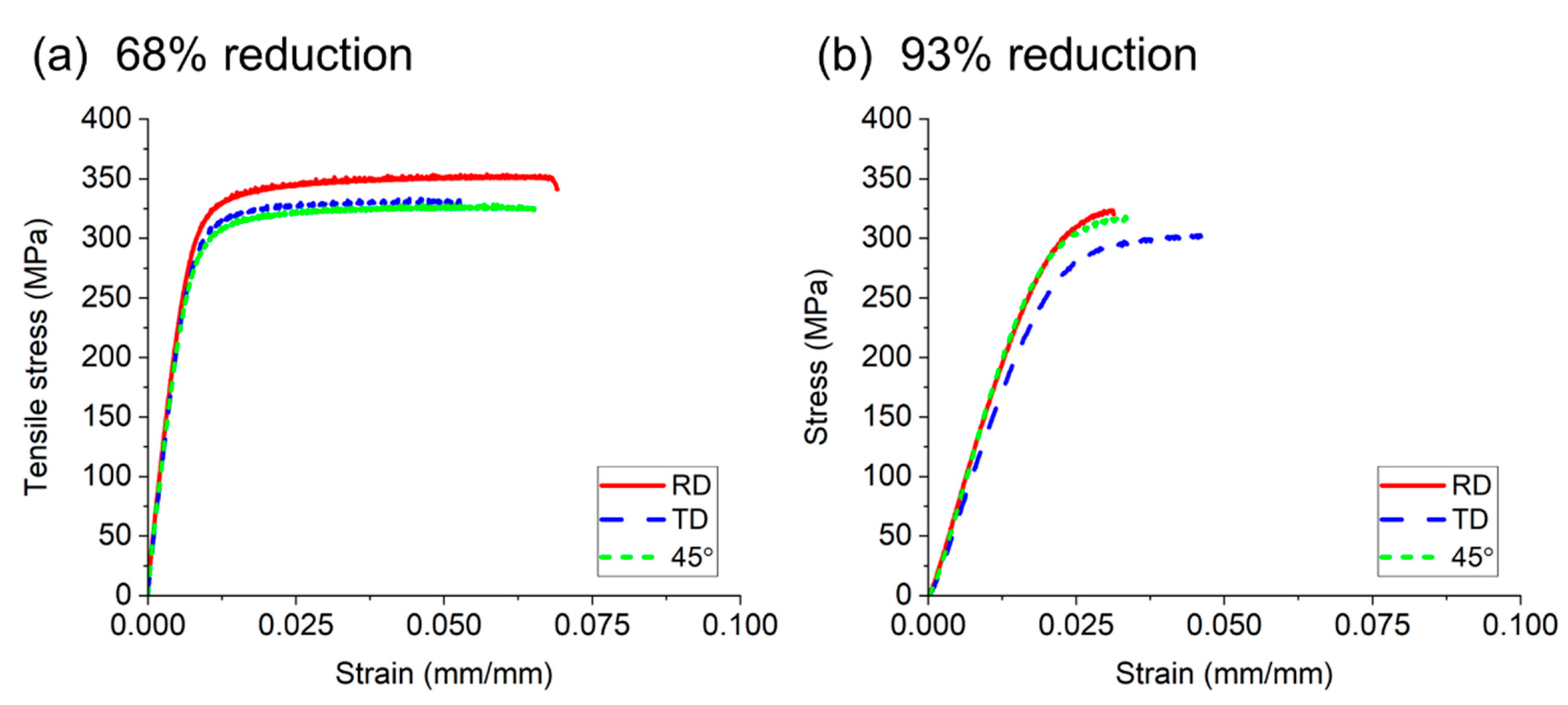Hot Rolling of ZK60 Magnesium Alloy with Isotropic Tensile Properties from Tubing Made by Shear Assisted Processing and Extrusion (ShAPE)
Abstract
1. Introduction
2. Experimental Methods
3. Results and Discussion
3.1. Microstructural Characterization of As-Extruded, 37% Rolled and 68% Rolled Samples
3.2. Mechanical Performance of the Rolled Plates
4. Conclusions
Author Contributions
Funding
Institutional Review Board Statement
Informed Consent Statement
Data Availability Statement
Acknowledgments
Conflicts of Interest
References
- Mordike, B.L.; Ebert, T. Magnesium Properties—Applications—Potential. Mater. Sci. Eng. A 2001, 302, 37–45. [Google Scholar] [CrossRef]
- Aghion, E.; Bronfin, B.; Eliezer, D. The Role of the Magnesium Industry in Protecting the Environment. J. Mater. Process. Technol. 2001, 117, 381–385. [Google Scholar] [CrossRef]
- Hirsch, J.; Al-Samman, T. Superior Light Metals by Texture Engineering: Optimized Aluminum and Magnesium Alloys for Automotive Applications. Acta Mater. 2013, 61, 818–843. [Google Scholar] [CrossRef]
- Joost, W.J.; Krajewski, P.E. Towards Magnesium Alloys for High-Volume Automotive Applications. Scr. Mater. 2017, 128, 107–112. [Google Scholar] [CrossRef]
- Whalen, S.; Overman, N.; Joshi, V.; Varga, T.; Gra, D.; Lavender, C. Magnesium Alloy ZK60 Tubing Made by Shear Assisted Processing and Extrusion ( ShAPE ). Mater. Sci. Eng. A 2019, 755, 278–288. [Google Scholar] [CrossRef]
- Lightweight Materials R&D: FY14 Annual Progress Report; Pacific Northwest National Laboratory: Richland, WA, USA, 2015.
- Bian, M.Z.; Sasaki, T.T.; Nakata, T.; Kamado, S.; Hono, K. Effects of Rolling Conditions on the Microstructure and Mechanical Properties in a Mg—Al—Ca—Mn—Zn Alloy Sheet. Mater. Sci. Eng. A 2018, 730, 147–154. [Google Scholar] [CrossRef]
- Suh, B.C.; Shim, M.S.; Shin, K.S.; Kim, N.J. Current Issues in Magnesium Sheet Alloys: Where Do We Go from Here? Scr. Mater. 2014, 84–85, 1–6. [Google Scholar] [CrossRef]
- Zeng, Z.; Nie, J.F.; Xu, S.W.; Davies, C.H.J.; Birbilis, N. Super-Formable Pure Magnesium at Room Temperature. Nat. Commun. 2017, 8, 972. [Google Scholar] [CrossRef] [PubMed]
- Wang, S.; Kang, S.B.; Cho, J. Effect of Hot Compression and Annealing on Microstructure Evolution of ZK60 Magnesium Alloys. J. Mater. Sci. 2009, 44, 5475–5484. [Google Scholar] [CrossRef]
- Wang, W.; Chen, W.; Zhang, W.; Cui, G.; Wang, E. Effect of Deformation Temperature on Texture and Mechanical Properties of ZK60 Magnesium Alloy Sheet Rolled by Multi-Pass Lowered-Temperature Rolling; Elsevier: Amsterdam, The Netherlands, 2018; Volume 712. [Google Scholar]
- Yuan, Y.; Ma, A.; Gou, X.; Jiang, J.; Lu, F.; Song, D.; Zhu, Y. Superior Mechanical Properties of ZK60 Mg Alloy Processed by Equal Channel Angular Pressing and Rolling; Elsevier: Amsterdam, The Netherlands, 2015; Volume 630. [Google Scholar]
- Styczynski, A.; Hartig, C.; Bohlen, J.; Letzig, D. Cold Rolling Textures in AZ31 Wrought Magnesium Alloy. Scr. Mater. 2004, 50, 943–947. [Google Scholar] [CrossRef]
- Taylor, G.I. Plastic Strain in Metals. J. Inst. Met. 1938, 62, 307–324. [Google Scholar]
- Jahedi, M.; McWilliams, B.A.; Knezevic, M. Deformation and Fracture Mechanisms in WE43 Magnesium-Rare Earth Alloy Fabricated by Direct-Chill Casting and Rolling. Mater. Sci. Eng. A 2018, 726, 194–207. [Google Scholar] [CrossRef]
- Zhang, H.; Cheng, W.; Fan, J.; Xu, B.; Dong, H. Improved Mechanical Properties of AZ31 Magnesium Alloy Sheets by Repeated Cold Rolling and Annealing Using a Small Pass Reduction. Mater. Sci. Eng. A 2015, 637, 243–250. [Google Scholar] [CrossRef]
- Somekawa, H.; Singh, A.; Mukai, T.; Inoue, T. Effect of Alloying Elements on Room Temperature Tensile Ductility in Magnesium Alloys. Philos. Mag. 2016, 96, 2671–2685. [Google Scholar] [CrossRef]
- Guo, H.; Zeng, X.; Fan, J.; Zhang, H.; Zhang, Q.; Li, W.; Dong, H.; Xu, B. Effect of Electropulsing Treatment on Static Recrystallization Behavior of Cold-Rolled Magnesium Alloy ZK60 with Different Reductions. J. Mater. Sci. Technol. 2019, 35, 1113–1120. [Google Scholar] [CrossRef]
- Wei, Y.H.; Wang, Q.D.; Zhu, Y.P.; Zhou, H.T.; Ding, W.J.; Chino, Y.; Mabuchi, M. Superplasticity and Grain Boundary Sliding in Rolled AZ91 Magnesium Alloy at High Strain Rates. Mater. Sci. Eng. A 2003, 360, 107–115. [Google Scholar] [CrossRef]
- Nugmanov, D.; Knezevic, M.; Zecevic, M.; Sitdikov, O.; Markushev, M.; Beyerlein, I.J. Origin of Plastic Anisotropy in (Ultra)-Fine-Grained Mg–Zn–Zr Alloy Processed by Isothermal Multi-Step Forging and Rolling: Experiments and Modeling. Mater. Sci. Eng. A 2018, 713, 81–93. [Google Scholar] [CrossRef]
- Cho, J.H.; Jeong, S.S.; Kang, S.B. Deep Drawing of ZK60 Magnesium Sheets Fabricated Using Ingot and Twin-Roll Casting Methods. Mater. Des. 2016, 110, 214–224. [Google Scholar] [CrossRef]
- Wang, C.; Ma, A.; Sun, J.; Liu, H.; Huang, H.; Yang, Z. Effect of ECAP Process on As-Cast and as-Homogenized Mg-Al-Ca-Mn Alloys with Different Mg2Ca Morphologies. J. Alloys Compd. 2019, 793, 259–270. [Google Scholar] [CrossRef]
- Agnew, S.R.; Horton, J.A.; Lillo, T.M.; Brown, D.W. Enhanced Ductility in Strongly Textured Magnesium Produced by Equal Channel Angular Processing. Scr. Mater. 2004, 50, 377–381. [Google Scholar] [CrossRef]
- Suh, J.; Victoria-Hernandez, J.; Letzig, D.; Golle, R.; Yi, S.; Bohlen, J.; Volk, W. Improvement in Cold Formability of AZ31 Magnesium Alloy Sheets Processed by Equal Channel Angular Pressing. J. Mater. Process. Technol. 2014, 217, 286–293. [Google Scholar] [CrossRef]
- Krystian, M.; Zehetbauer, M.J.; Kropik, H.; Mingler, B.; Krexner, G. Hydrogen Storage Properties of Bulk Nanostructured ZK60 Mg Alloy Processed by Equal Channel Angular Pressing. J. Alloys. Compd 2011, 509, S449–S455. [Google Scholar] [CrossRef]
- Kruska, K.; Clark, T.; Darsell, J.; Overman, N.R.; Whalen, S.A.; Bowden, M.E.; Olszta, M.J.; Kruska, K.; Clark, T.; Stevens, E.L.; et al. Homogenization and Texture Development in Rapidly Solidified AZ91E Consolidated by Shear Assisted Processing and Extrusion (ShAPE). Mater. Sci. Eng. A 2017, 701, 56–68. [Google Scholar] [CrossRef]
- Darsell, J.T.; Overman, N.R.; Joshi, V.V.; Whalen, S.A.; Mathaudhu, S.N. Shear Assisted Processing and Extrusion ( ShAPE Ô ) of AZ91E Flake: A Study of Tooling Features and Processing Effects. J. Mater. Eng. Perform. 2018, 27, 4150–4161. [Google Scholar] [CrossRef]
- Jamalian, M.; Joshi, V.V.; Whalen, S.; Lavender, C.; Field, D.P. Microstructure and Texture Evolution of Magnesium Alloy after Shear Assisted Processing and Extrusion ( ShAPE TM ). In Proceedings of the IOP Conference Series: Materials Science and Engineering, St George, UT, USA, 6–10 November 2017; Volume 375, p. 012007. [Google Scholar] [CrossRef]
- Whalen, S.; Joshi, V.; Overman, N.; Caldwell, D.; Lavender, C.; Skszek, T. Scaled-Up Fabrication of Thin-Walled ZK60 Tubing Using Shear Assisted Processing and Extrusion (ShAPE). In Magnesium Technology; Springer: Berlin/Heidelberg, Germany, 2017; ISBN 9783319523927. [Google Scholar]
- Beura, V.; Zhang, D.; Overman, N.; Darsell, J.; Herling, D.R.; Solanki, K.; Joshi, V.V. Enhanced Mechanical Behavior and Corrosion Resistance of AZ31 Magnesium Alloy through a Novel Solid-Phase Processing. Corros. Sci. 2022, 197. [Google Scholar] [CrossRef]
- Choi, J.P.; Lavender, C.; Mattlin, K.; Dahl, M. High-Temperature Aluminum Alloys; Pacific Northwest National Laboratory: Richland, WA, USA, DOE Annual Merit Review; 2013. [Google Scholar]
- Dumitru, F.D.; Higuera-Cobos, O.F.; Cabrera, J.M. ZK60 Alloy Processed by ECAP: Microstructural, Physical and Mechanical Characterization. Mater. Sci. Eng. A 2014, 594, 32–39. [Google Scholar] [CrossRef]
- Lin, J.; Wang, Q.; Peng, L.; Roven, H.J. Microstructure and High Tensile Ductility of ZK60 Magnesium Alloy Processed by Cyclic Extrusion and Compression. J. Alloys Compd. 2009, 476, 441–445. [Google Scholar] [CrossRef]
- Xu, C.; Zheng, M.Y.; Chang, H.; Hu, X.S.; Wu, K.; Gan, W.M.; Brokmeier, H.G. Microstructure and Properties of Pure Mg/ZK60 Laminate Processed by Accumulative Roll Bonding. Mater. Sci. Forum 2010, 650, 343–346. [Google Scholar] [CrossRef]
- Huang, W.; Huo, Q.; Fang, Z.; Xiao, Z.; Yin, Y.; Tan, Z.; Yang, X. Damage Analysis of Hot-Rolled AZ31 Mg Alloy Sheet during Uniaxial Tensile Testing under Different Loading Directions. Mater. Sci. Eng. A 2018, 710, 289–299. [Google Scholar] [CrossRef]
- Wei, Y.; Lu, L.; Li, M.; Ma, M.; Huang, W.; Zhao, X.; Wu, R. Effect of 90° Route on Microstructure of AZ31 Magnesium Alloy Sheets by Forging-Bending Repeated Deformation. J. Alloys Compd. 2023, 948, 169720. [Google Scholar] [CrossRef]
- Yi, S.B.; Davies, C.H.J.; Brokmeier, H.G.; Bolmaro, R.E.; Kainer, K.U.; Homeyer, J. Deformation and Texture Evolution in AZ31 Magnesium Alloy during Uniaxial Loading. Acta Mater. 2006, 54, 549–562. [Google Scholar] [CrossRef]
- Liu, X.; Wang, Y.; Zhu, B.; Xie, C.; Sun, Y.; Yang, H. Effect of Microstructures and Textures on the Anisotropy of Mechanical Properties of AZ31 Magnesium Alloy Sheets Subjected to High Strain Rate Rolling. Mater. Res. Express 2019, 6, 106591. [Google Scholar] [CrossRef]
- Su, H.; Chu, Z.; Xue, C.; Li, Y.; Ma, L. Relationship among Initial Texture, Deformation Mechanism, Mechanical Properties, and Texture Evolution during Uniaxial Compression of Az31 Magnesium Alloy. Crystals 2020, 10, 1–12. [Google Scholar] [CrossRef]
- Beyerlein, I.J.; McCabe, R.J.; Tomé, C.N. Effect of Microstructure on the Nucleation of Deformation Twins in Polycrystalline High-Purity Magnesium: A Multi-Scale Modeling Study. J. Mech. Phys. Solids 2011, 59, 988–1003. [Google Scholar] [CrossRef]
- Wu, X.L.; Youssef, K.M.; Koch, C.C.; Mathaudhu, S.N.; Kecskés, L.J.; Zhu, Y.T. Deformation Twinning in a Nanocrystalline Hcp Mg Alloy. Scr. Mater. 2011, 64, 213–216. [Google Scholar] [CrossRef]
- Fereshteh-Saniee, F.; Fakhar, N.; Karami, F.; Mahmudi, R. Superior Ductility and Strength Enhancement of ZK60 Magnesium Sheets Processed by a Combination of Repeated Upsetting and Forward Extrusion. Mater. Sci. Eng. A 2016, 673, 450–457. [Google Scholar] [CrossRef]
- Yi, D.; Gu, W.; Fang, X.; Wang, B.; Luo, W. Plastic Deformation Behaviors and Dynamic Recrystallization Mechanisms of ZK60 Magnesium Alloy. Int. J. Soc. Mater. Eng. Resour. 2006, 14, 33–39. [Google Scholar] [CrossRef]
- Gong, X.; Gong, W.; Bong, S.; Hyung, J. Effect of Warm Rolling on Microstructure and Mechanical Properties of Twin-Roll Casted ZK60 Alloy Sheets. Mater. Res. 2015, 18, 360–364. [Google Scholar] [CrossRef]
- Jin, W.; Fan, J.; Zhang, H.; Liu, Y.; Dong, H.; Xu, B. Microstructure, Mechanical Properties and Static Recrystallization Behavior of the Rolled ZK60 Magnesium Alloy Sheets Processed by Electropulsing Treatment. J. Alloys Compd. 2015, 646, 1–9. [Google Scholar] [CrossRef]








| Direction | 68% Reduction | 93% Reduction | ||||
|---|---|---|---|---|---|---|
| YS (MPa) | UTS (MPa) | ETF % | YS (MPa) | UTS (MPa) | ETF % | |
| RD | 292.16 ± 1.11 | 341.74 ± 5.96 | 6.95 ± 1.94 | 256.93 ± 18.4 | 260.76 ± 22.4 | 3.38 ± 0.51 |
| TD | 286.19 ± 1.13 | 336.09 ± 1.58 | 5.15 ± 0.05 | 251.91 ± 18.9 | 262.83 ± 21.2 | 4.00 ± 0.87 |
| 45° | 284.33 ± 3.18 | 334.61 ± 2.12 | 6.31 ± 0.71 | 272.81 ± 19.1 | 289.28 ± 14.8 | 3.64 ± 0.12 |
Disclaimer/Publisher’s Note: The statements, opinions and data contained in all publications are solely those of the individual author(s) and contributor(s) and not of MDPI and/or the editor(s). MDPI and/or the editor(s) disclaim responsibility for any injury to people or property resulting from any ideas, methods, instructions or products referred to in the content. |
© 2023 by the authors. Licensee MDPI, Basel, Switzerland. This article is an open access article distributed under the terms and conditions of the Creative Commons Attribution (CC BY) license (https://creativecommons.org/licenses/by/4.0/).
Share and Cite
Frazier, W.E.; Overman, N.; Schuessler, B.; Niverty, S.; Roosendaal, T.; Whalen, S.; Joshi, V.V. Hot Rolling of ZK60 Magnesium Alloy with Isotropic Tensile Properties from Tubing Made by Shear Assisted Processing and Extrusion (ShAPE). Appl. Sci. 2023, 13, 5343. https://doi.org/10.3390/app13095343
Frazier WE, Overman N, Schuessler B, Niverty S, Roosendaal T, Whalen S, Joshi VV. Hot Rolling of ZK60 Magnesium Alloy with Isotropic Tensile Properties from Tubing Made by Shear Assisted Processing and Extrusion (ShAPE). Applied Sciences. 2023; 13(9):5343. https://doi.org/10.3390/app13095343
Chicago/Turabian StyleFrazier, William E., Nicole Overman, Benjamin Schuessler, Sridhar Niverty, Timothy Roosendaal, Scott Whalen, and Vineet V. Joshi. 2023. "Hot Rolling of ZK60 Magnesium Alloy with Isotropic Tensile Properties from Tubing Made by Shear Assisted Processing and Extrusion (ShAPE)" Applied Sciences 13, no. 9: 5343. https://doi.org/10.3390/app13095343
APA StyleFrazier, W. E., Overman, N., Schuessler, B., Niverty, S., Roosendaal, T., Whalen, S., & Joshi, V. V. (2023). Hot Rolling of ZK60 Magnesium Alloy with Isotropic Tensile Properties from Tubing Made by Shear Assisted Processing and Extrusion (ShAPE). Applied Sciences, 13(9), 5343. https://doi.org/10.3390/app13095343








